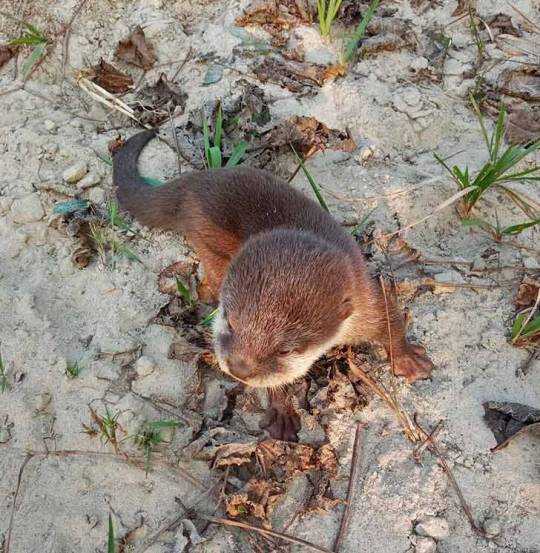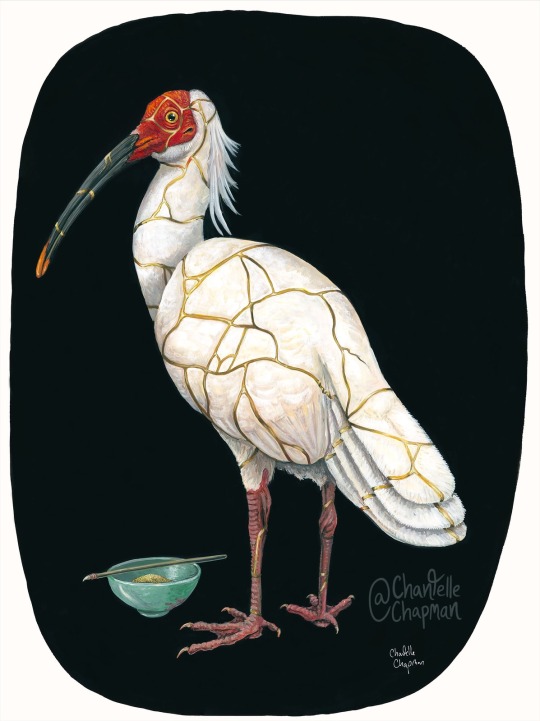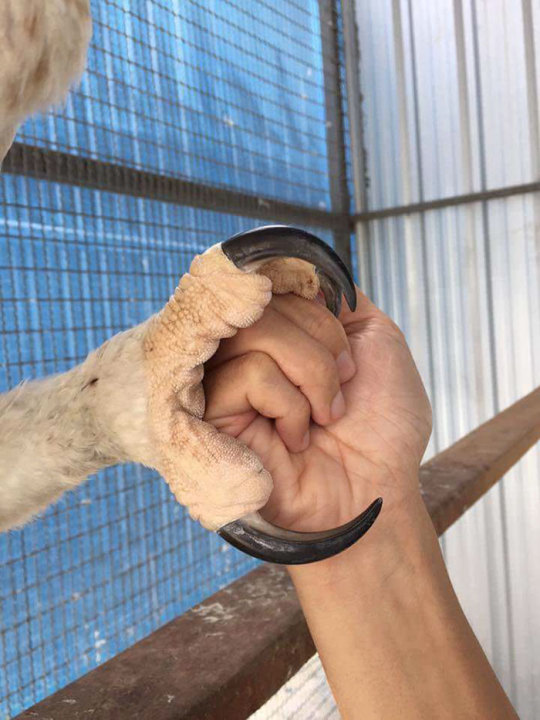#endangered wild species
Explore tagged Tumblr posts
Text

please dear god everyone look at this przewalski's horse i found on inaturalist
#przewalski's horse#wild horse#wild horses#horses#endangered species#inaturalist#austria#hungary#animals#matt speaks
15K notes
·
View notes
Text
Scientists have for the first time in 185 years confirmed the presence of the Asian small-clawed otter in Nepal, thrilling conservationists and researchers looking for clues to its existence here.
The last time the Asian small-clawed otter (Aonyx cinereus), the smallest of the world’s 13 known otter species, was recorded by scientists in Nepal was in 1839.
“After years of speculation about its presence in Nepal, we can finally confirm that the small-clawed otter lives on in the country,” said Mohan Bikram Shrestha, the lead author of a short note published in the latest edition of the bulletin of the Otter Specialist Group at the IUCN, the global wildlife conservation authority.
Although historically three species of otters are believed to occur in Nepal, modern researchers had until now only confirmed the presence of smooth-coated otters (Lutrogale perspicillata) and Eurasian otters (Lutra lutra), with a question mark hanging over the small-clawed otter. During that time, reports have come in, never confirmed until now, of small-clawed otter sightings in Makalu Barun National Park in Nepal’s eastern Himalayas and Kailali and Kapilvastu districts in the western plains...
“As it was found in a fragile and injured state, the forest officers decided to feed and nurse it, but they didn’t know which species it belonged to,” Shrestha. The forest officers, led by Rajeev Chaudhary, shared the images and video of the animal, known locally as saano owt, with the IUCN Otter Specialist Group. The members of the group then confirmed it to be a small-clawed otter.
The discovery comes after the species was confirmed for the first time in 2022 in the Darjeeling area of neighboring India, which shares a similar topography with eastern Nepal. “Following the discovery in Darjeeling, we had been keeping our eyes open for the species in eastern Nepal, but it showed up in the west,” Shrestha said.
There have also been reports of sightings of the animal in the eastern parts of the country, but none of them have been confirmed.
The Asian small-clawed otter is classified as vulnerable to extinction on the IUCN Red List. Its range stretches from Indonesia in the east to Nepal in the west...
As for smooth-coated otters, although their presence in the country has never been in question, sightings of them still excite conservationists. This was especially the case in Chitwan National Park, where their reappearance in September 2023 after two decades spurred calls for more research.
“This is an incredibly significant finding,” Sanjan Thapa, deputy coordinator of the Otter Specialist Group’s Himalayan region, said of the latest development. “We had long suspected that the Asian small-clawed otter might still survive in Nepal, but without concrete evidence, its status remained uncertain.”
Thapa, part of the team that confirmed the 2023 sighting of the smooth-coated otter in Chitwan, said researchers tend to feel a bit edgy about a species when it hasn’t been reported for more than 50 years.
“We had received suggestions that we remove the small-clawed otter from the Nepal otter list as it hadn’t been found for a long time,” he said. “However, we decided not to do so in the hope that it would be rediscovered sooner or later.”

The discovery adds to the challenge of saving Nepal’s otters as the country prepares to finalize and implement an action plan for otters, Thapa said. “Now that we have concrete proof that the small-clawed otter is also found in Nepal, we need to incorporate it in our policies and programs,” he said.
Both Eurasian and smooth-coated otters are protected under the country’s Aquatic Animal Protection Act. The newly rediscovered species, however, isn’t on the list. “The first step would be to add the species to the list,” Thapa said."
-via Mongabay, February 5, 2025
#otters#endangered species#mustelid#nepal#asia#india#conservation#wildlife#wild animals#wildlife photography#baby animals#good news#hope
4K notes
·
View notes
Text
getting emotional over footage of an amateur scuba diver interacting with a coelacanth. they are hunted by large deepwater predators, and here comes a large creature bearing the brightest lights it's ever seen, making strange noises, but it does not shy away. it hovers, calmly, as the diver reaches out and trails a hand down its back. im strongly against the anthropomorphizing of real life animals but the stupid emotional part of me loudly insists this is because it recognizes us, the alternating movements of its four paired limbs matching the diver's four paired limbs, & it is thinking, "hello, cousins, we missed you these 66 million years, it's so good to see you again. welcome back, welcome home."
#[OBLIGATORY DISCLAIMER: he should NOT have touched the fish. do NOT touch random fish you find while scuba diving#especially if the fish is 6ft long & has sharp teeth#ESPECIALLY if the fish is a critically endangered species#being overwhelmed by the majesty of the coelcanth is understandable but that does not excuse his behavior]#[obligatory disclaimer 2: i know nothing about this guy; by 'amateur' i just mean he wasnt part of a scientific expedition at the time]#[obligatory disclaimer 3: i mean it wasnt CALM. its first dorsal fin was erect which we have reason to believe means it is on edge.#but it didnt flee like you would expect of a wild animal]#...disclaimers over. now im going to wail about how life began in the sea and we left & they stayed#& we thought they were gone & now we're finding our way back home to them#they are so beautiful and they are our family and they love us ok. they do i know it in my heart#coelacanth#Latimeria chalumnae#animals#andy original#ALSO I KNOW THEY HAVE 8 FINS by four paired limbs i mean the pelvic and pectoral the others arent paired they dont move like legs do
9K notes
·
View notes
Text

[ID: an illustration of a ruddy red, black, and beige horse facing to the left, with one hoof up. It is on a green background with simple orange grasses. End.]
Przewalski’ s horse! The last remaining species of wild horse, once extinct in the wild, it has been slowly bouncing back as a result of organized conservation efforts. They’re an important fixture in a healthy Mongolian steppe ecosystem.
659 notes
·
View notes
Text
From the article:
Along the sandy shores of Sekania, on the Ionian island of Zakynthos, what she has seen both this year and last, has been beyond her wildest dreams. The beach, long described as the Mediterranean’s greatest “maternity ward” for the Caretta caretta loggerhead sea turtle, has become host to not only record numbers of nests, but record numbers of surviving hatchlings as the species makes an extraordinary resurgence. “The message sea turtles are sending is very clear,” said Minotou, who coordinates the WWF programme in the protected area. “And that is the measures we have taken over the past 25 years to ensure conditions are right for the marine turtles to nest here are working … It’s fantastic.”
#hope#good news#environment#conservation#endangered species#biodiversity#hopepunk#sea turtle conservation#sea turtle#wild animals#animal conservation
886 notes
·
View notes
Text




The Dracula Parrot, New Guinea
rawrszn
#Pesquet's parrot#Psittrichas fulgidus#birds#rainforest#wildlife#endangered species#don't poach#don't buy wild animals!#curators on tumblr
635 notes
·
View notes
Text
If you've ever shared "cute" pictures or videos from owl cafes, read this sobering reality check.
92 cafes across Japan hold over 1900 owls captive, simply for entertainment. This includes two species considered Near Threatened (Barred Eagle-owl Bubo sumatranus and Chaco Owl Strix chacoensis) and one Vulnerable species (Snowy Owl Bubo scandiacus). Moreover, there is a lack of transparency as to the origins of many of these owls, which may not all have been captive-bred. Species may have been mislabeled during import, and not all have paperwork showing they were legally imported, meaning there is a very good chance owl cafes feed into the illicit, non-sustainable wildlife trade.
What the article doesn't cover is how stressful these settings are for owls. They're bright, noisy, and confined, and the owls are exploited by the owners who allow untrained strangers to hold and pet them without consideration of the owl's well-being. The "break areas" where the owls can get away from direct contact are still within sight of patrons, meaning they are still subject to human contact.
Owls are not chickens. They are not domesticated birds that have spent thousands of years and thousands of generations in human company, being selectively bred for human-friendly, docile traits. Even a tame owl is still a wild animal with intact instincts that tell it it should be living a largely solitary life in a wide, open field or forest, not stuck in a small space with many other owls of assorted species and a bunch of people.
This also isn't a situation like falconry, where captive birds are given plenty of private space, and flown daily for physical and mental fitness. And a single cage may have dozens of owls, more than what limited staff can handle. Even if some of the birds are supposedly "rescues" (as at least one cafe's website claims), any reputable wildlife rescue is going to limit the contact between the animals and humans, and absolutely is not going to allow visitors to regularly take pictures with and handle the wildlife--even socialized, trained ambassador animals have very stringent limitations on direct contact.
So it's not at all unsurprising that an already highly unethical industry is likely contributing to the problem of questionable or illegal wildlife trade. This study is just one more piece of evidence suggesting that these cafes are anything but harmless, cute fun.
#owl cafe#owl cafes#owls#birds#birdblr#wildlife#wild animals#animal welfare#animal cruelty#wildlife trafficking#Japan#nature#animals#ecology#conservation#endangered species#wildlife rescue#wildlife rehab#not actually cute
507 notes
·
View notes
Text
Holo Pangolin!

And a mini Holo Pangolin!
#joyousjoyfuljoyness#my art#foil art#foiling#oddly satisfying#satisfying#shiny#drawing#pangolin#cute animals#artists on tumblr#cute art#wild animals#wildlife#endangered species#endangered animals#critically endangered#animals#holographic#holographic aesthetic#animal drawing
316 notes
·
View notes
Text

Two hundred years ago, the wetlands of Japan rustled with pink-tinged feathers. Tall, pale birds stepped carefully through reeds and iris, hunting small fish, crabs, and frogs.
Nipponia nippon, it would be dubbed by the national ornithological society, a bird emblematic of its country. The Crested Ibis. The Toki. The Peach Flower Bird.
Marshes slowly changed to rice fields, with farmers who resented the toki for ruining crops; to kill the birds was outlawed, so children chased them from the fields, singing warnings.
The doors of the country were pried open. Laws changed. Farmers bought their first guns, their sights set on birds who were no longer protected. The toki, the red-crowned crane, and many others began to suffer. But the worst was yet to come.
Pesticides are indiscriminate killers. The poison sprayed to kill a beetle can travel up the foodchain, toppling a cascade of larger animals, or affecting their ability to reproduce. It was reckless pesticide use that nearly wiped out the Bald Eagle. In the rice fields, the peach-flower-bird had little chance.
In 1981, Japan’s last five living toki were removed from a wild that had become too dangerous for them.
I tell a lot of sad stories here, about mistakes we’ve made and animals we’ve lost. This isn’t one of those. This is a story about one of those precious times when we were able to fix the things we’d broken.
A joint effort between Japan & China, and the discovery of seven more birds in that country, led to a successful breeding program, which in 2008 saw the first ibises fly free again in Japan. Today, at least 5000 toki exist in the world.
The last wild-born toki, one of those captured in 1981, lived almost long enough to see her species’ return. Reaching the equivalent age of a centenarian human, she died in 2003—not of old age, but injury after throwing herself against her cage door.
Her name was ‘Kin’. ‘Gold’.
Mended things can never be as whole as they once were. There will always be cracks that show, weak spots that remain vulnerable. Yet, like the shining seams of a kintsugi piece, these scars speak an important truth: here is a thing that someone chose to save; handle with care.
The title of this painting is ‘Restoration’. It is gouache on 22x30 inch watercolor paper, and is part of my series 'Conservation Pieces', exploring the effort to preserve endangered birds.
#bird art#endangered species#extinct in the wild#toki#crested ibis#extinction stories#series: conservation pieces
4K notes
·
View notes
Text
youtube
In the northeastern part of India, the greater adjutant stork has been considered an ill omen for generations, and the endangered bird has paid the price. Its breeding population here fell to just 115 birds by the 1990s.
But when biologist Purnima Devi Barman witnessed villagers chop down a tree crowned with the storks’ nests — and chicks — she launched a grassroots effort to do something about it. Today, 10,000 women across the region have banded together to protect nests, raise fledglings, and run educational programs for children and adults explaining the benefits the storks bring to their communities. They even produce textiles that celebrate the giant bird — and bring critical income and empowerment to the local women who are safeguarding its future.
These efforts have been a resounding success for greater adjutant stork conservation. A recent survey found 1,830 of the distinctive birds in Assam, and the species’ status on the IUCN Red List has been changed from “endangered” to “near threatened” — a testament to what can be achieved with community conservation.
#Nature on PBS#wild hope#solarpunk#india#Assam#greater adjutant stork#stork#hargila#bird#endangered species#near threatened species#conservation#Purnima Devi Barman#grassroots#Youtube#Asia
311 notes
·
View notes
Text

wolf conservation center
#grey wolves#arctic wolf#grey wolf#canines#animals#mammals#nature#wolf#wolves#wolf photography#photography#canidae#canids#gray wolf#wolf pack#wolf posting#wolf posts#wolfdog#appreciate nature#nature photography#endangered animals#animal photography#wolf conservation center#endangered species#arctic wolves#wild wolf#natural world
99 notes
·
View notes
Text


Harpy eagle, the largest eagle in the world looks like a person in a bird costume, but judging by the size of his talons, I wouldn't want to make fun of him face to face. They live primarily in the upper canopy layer of tropical lowland forest and are considered "endangered species" in Central America due to the rapid decline in their numbers as a result of deforestation. Less than 50,000 of them can be seen over the world.
Harpy eagles have a hearty appetite and enjoy munching on a variety of monkeys, tree porcupines, sloths, coatis, birds, snakes, and lizards.
#harpy eagle#birds#birds of prey#largest birds#largest eagle#endangered species#goofy looking birds#huge talons#no handshake please#scary claws#wildlife#wild animals#nature#wow#bird lovers#birdwatching#birding
757 notes
·
View notes
Text
"The British equivalent of the Audubon Society has just announced that what was already England’s largest bird reserve will be increased by 33% after a recent land purchase.
Described as a place that “swarms” with life, the Geltsdale Reserve in the North Pennines range of Cumbria, northern England, will now cover 13,590 acres of moorland, meadows, blanket bog, and woodland.
Owned and operated by the Royal Society for the Protection of Birds (RSPB), Geltsdale is one of the last places in Britain where one can see the hen harrier in its natural habitat. Birds of every description and conservation status inhabit the reserve, and it’s also a UNESCO Geopark for its unique geological formations.
“This is going to be a reserve on a different scale from many of our other sites in England,” said Beccy Speight, the RSPB’s chief executive.

For birdwatchers reading, Geltsdale abounds in black grouse, redshank, nightjar, snipe, whinchat, curlews, ospreys, short-eared owls, and lapwings, dispersed across a vertical rise of 650 meters from an achingly green valley bottom up stately moorland and pasture at an elevation similar to the lower-peaks of the Appalachian range.
“Geltsdale is now the biggest in England,” said Speight. “And that size makes such a difference. When you walk through the reserve during breeding season, it is incredible. The place just swarms with birdlife.”...
Additionally, a lot of age-old practices such as heather burning and moorland draining have been halted to ensure the area can get back to its absolute natural best."
-via Good News Network, February 6, 2025
#england#uk#united kingdom#europe#birds#birdwatching#wild birds#ornithology#conservation#endangered species#moors#wetlands#birdblr#good news#hope
995 notes
·
View notes
Text

WHOLE FLOCK OF GROSBEAKS JISY STOPPED BY GOLY SHIT IM STOKED
#grosbeak#evening grosbeak#endangered species#birblr#birds#nature#wildlife#ornithology#wild birds#birdwatching#bird photography#birdbuddy
87 notes
·
View notes
Text

Denver Aquarium.
June 2024.
This is one of my favorite pictures that I have ever taken.
Got to love the blep.
#Tigers#Wildlife#Tiger Photography#Big Cats#Wild Cats#Endangered Species#Zoo Animals#Animal Conservation#DenverAquarium#MissedMileMarkers
62 notes
·
View notes
Text
Am I the only one who thinks there's been a very sudden lack of Gourmand in Season 7?
#wild kratts#pbs kids#pbs#martin kratt#chris kratt#gaston gourmand#wild kratts fandom#Like the only individual appearance he's had was back in the premiere episode#And that's when we're introduced to his pet hound dog who ALSO for some reason hasn't been seen at all since#And Zachary Bennett has been very present as Zach this season so I'm not entirely sure why Gourmand is taking a backseat#Atp bro's BECOME an endangered species ☠️
26 notes
·
View notes